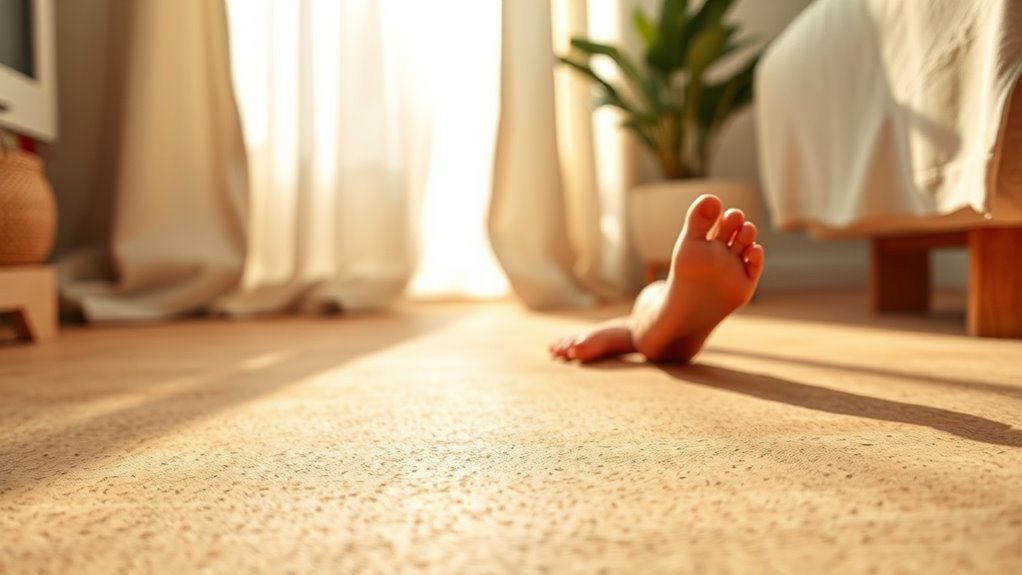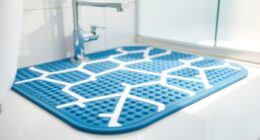To choose flooring that’s easy on your feet, look for soft, cushioned materials like cork, rubber, or plush carpets with padding. These surfaces absorb shock, reduce joint stress, and offer better support during long periods of standing or walking. Slip-resistant textures and proper installation also boost safety and comfort. For more tips on creating a foot-friendly environment, discover how to select the best options tailored to your needs.
Key Takeaways
- Select soft, shock-absorbing materials like cork, rubber, or plush carpet to reduce joint impact and foot fatigue.
- Prioritize slip-resistant surfaces with textured finishes to prevent slips and enhance safety.
- Ensure proper installation with a level, debris-free subfloor and quality underlayment for maximum comfort.
- Incorporate supportive features such as thick padding or area rugs to add cushioning and warmth.
- Choose eco-friendly options like bamboo or reclaimed hardwood for sustainable, healthy, and foot-friendly flooring.
Key Factors to Consider When Selecting Foot-Friendly Flooring
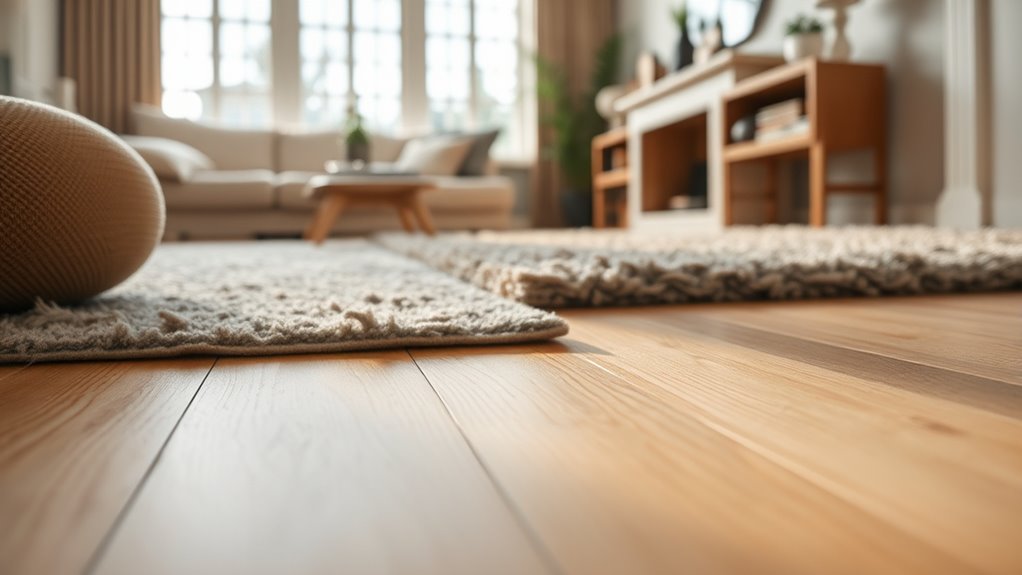
When choosing foot-friendly flooring, it’s essential to take into account how the material impacts your joints and overall comfort. Look for options with good shock absorption, like cork, rubber, or carpet, which help reduce impact on your feet and joints during daily activities.
Soft flooring provides a more comfortable walking surface, especially for prolonged standing or walking, minimizing fatigue. Additionally, prioritize slip-resistant surfaces, such as textured tiles or rubber, to prevent slips and falls, ensuring safety for everyone.
Durable materials that are easy to clean keep your flooring foot-friendly over time without becoming hazardous. Finally, consider how well the flooring supports barefoot walking; natural options like cork or bamboo offer softness, insulation, and a gentle feel underfoot, enhancing overall comfort.
The Benefits of Soft and Cushioned Flooring Options
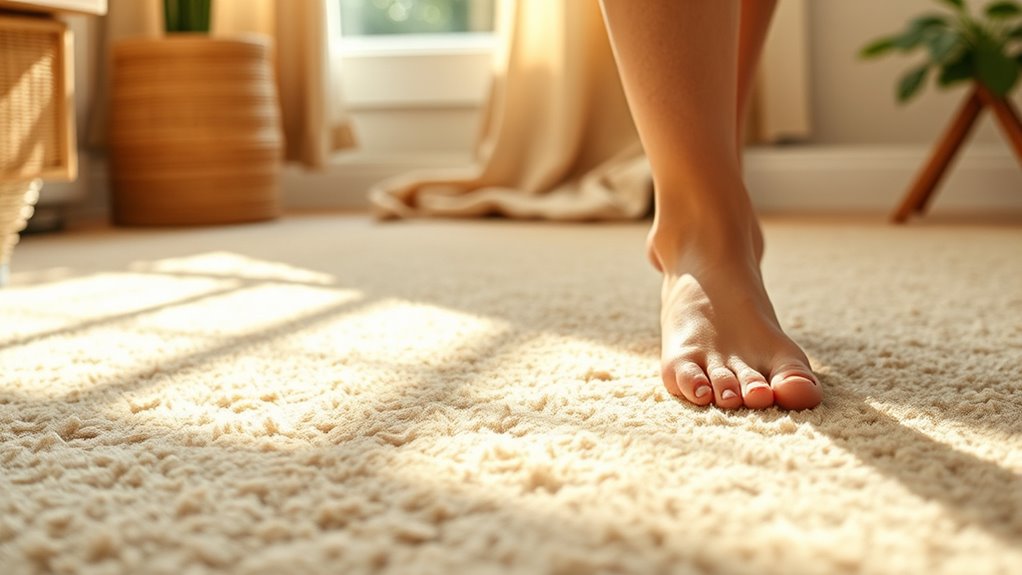
Soft and cushioned flooring options like carpet, cork, and rubber can make a real difference in your daily comfort. They absorb impact, reducing joint stress and lowering the risk of slips and falls. Choosing these surfaces supports better foot health and overall safety in your space. Additionally, materials like cork and rubber are known for their shock absorption properties, enhancing comfort during long periods of standing or walking. Incorporating flooring with impact-absorbing qualities can further improve safety and comfort in high-traffic or active areas. Using anti-fatigue flooring can also help reduce fatigue when standing for extended periods, making your environment more comfortable overall.
Enhanced Joint Comfort
Choosing flooring that’s soft and cushioned can make a significant difference in reducing joint strain and foot pain, especially during long periods of standing or walking. Soft surfaces like carpet, cork, and rubber provide excellent shock absorption, which helps cushion your joints and lessen the impact forces transmitted through your feet. Additionally, incorporating automation technologies into the manufacturing of these flooring options can enhance quality control and consistency. Cork flooring naturally absorbs shock, supporting joint health by minimizing impact on your knees and hips. Rubber flooring also excels at impact absorption and slip resistance, making it ideal for reducing joint stress during physical activities.
Improved Safety and Support
Opting for soft and cushioned flooring options like carpet, cork, or rubber substantially enhances safety and support in your space. Cushioned surfaces absorb shock, reducing impact stress on your feet and joints. They also improve slip resistance, making high-traffic or safety-critical areas less hazardous. Wood-burning stoves are an example of efficient heating solutions that can complement cushioned flooring by providing cozy warmth; integrating both can create a comfortable and safe environment. Supportive flooring helps alleviate foot fatigue and pain, encouraging healthier posture and gait during long periods of standing or walking. Resilient, padded floors can prevent injuries from falls while providing added stability. Proper selection of soft flooring boosts overall safety and foot health by reducing pressure points and accommodating mobility issues. Additionally, choosing the right soft flooring can enhance room acoustics by dampening noise and echo, creating a more peaceful environment. Incorporating foot support considerations into your flooring choice can further promote comfort and prevent long-term foot problems.
Comparing Hard Surfaces and Their Impact on Foot Comfort
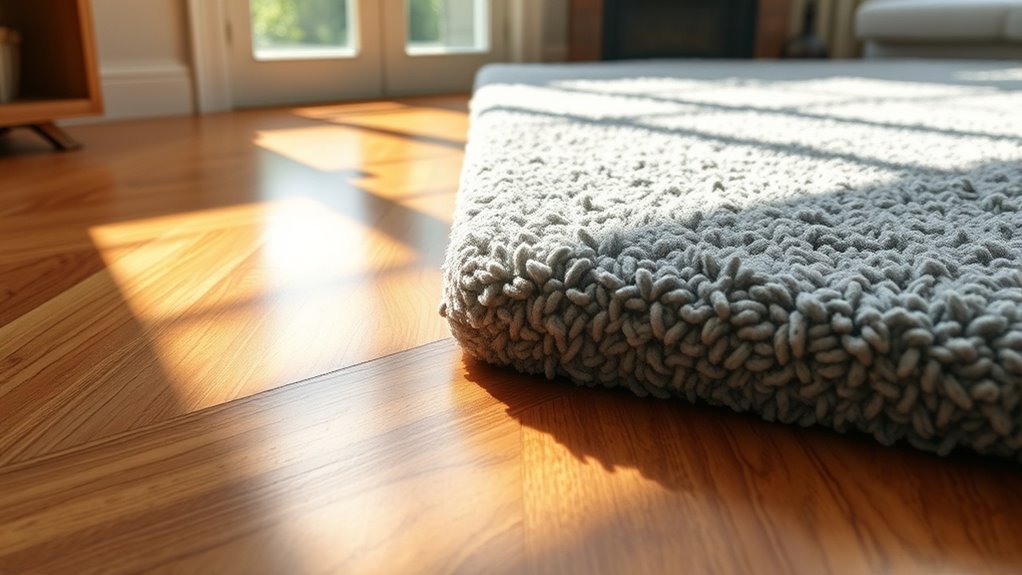
Materials with better shock absorption, such as cork or rubber, help reduce joint strain and enhance comfort. Incorporating smart features like poolside cabanas or shaded seating areas can also improve relaxation and foot comfort around your outdoor space. Regularly reviewing and adjusting your choices ensures ongoing comfort benefits. Additionally, selecting foot-friendly flooring options can further support overall foot health and prevent discomfort during prolonged standing or walking.
Hard Floor Impact
Hard surfaces like tile and hardwood can substantially increase the impact forces on your feet, leading to discomfort and potential joint stress. These hard floors offer less shock absorption, making each step harsher on your feet, knees, and hips. Using proper footwear designed for hard surfaces can also help reduce impact and protect your joints. Additionally, understanding the importance of shock absorption can guide you in selecting appropriate flooring options and accessories. If you suffer from foot pain or arthritis, prolonged standing on these surfaces can worsen your condition. To minimize impact, consider adding area rugs or mats, which help cushion your steps and reduce fatigue. Without proper support, hard floors can cause discomfort over time, especially during extended periods of standing. Incorporating cushioning options like foam underlays or padded mats can greatly improve comfort and reduce strain on your joints. Selecting softer flooring such as cork or carpet can provide natural shock absorption benefits and enhance overall foot comfort. Moreover, choosing flooring materials with ergonomic design features can further improve foot health and comfort during daily activities.
Support and Stability
Since many flooring options differ in their support and stability, choosing the right surface can considerably influence your foot comfort. Hard surfaces like tile and hardwood lack shock absorption, which can lead to increased foot fatigue and discomfort over time. Soft flooring options such as cork, rubber, or plush carpets offer better support, helping reduce joint stress during prolonged standing or walking. Resilient materials like cork and foam-backed carpets promote proper foot alignment, minimizing strain. Surfaces with high shock absorption, like rubber or cushioned vinyl, decrease impact forces transmitted to your feet and joints, enhancing comfort. Additionally, flooring with good grip and stability prevents slips and falls, providing extra support and safety. Incorporating textile-based flooring options like carpets can further improve comfort by adding a cushioning layer. Prioritizing support and stability ensures your feet stay comfortable and well-protected throughout the day.
Top Flooring Materials for Reducing Joint and Foot Pain
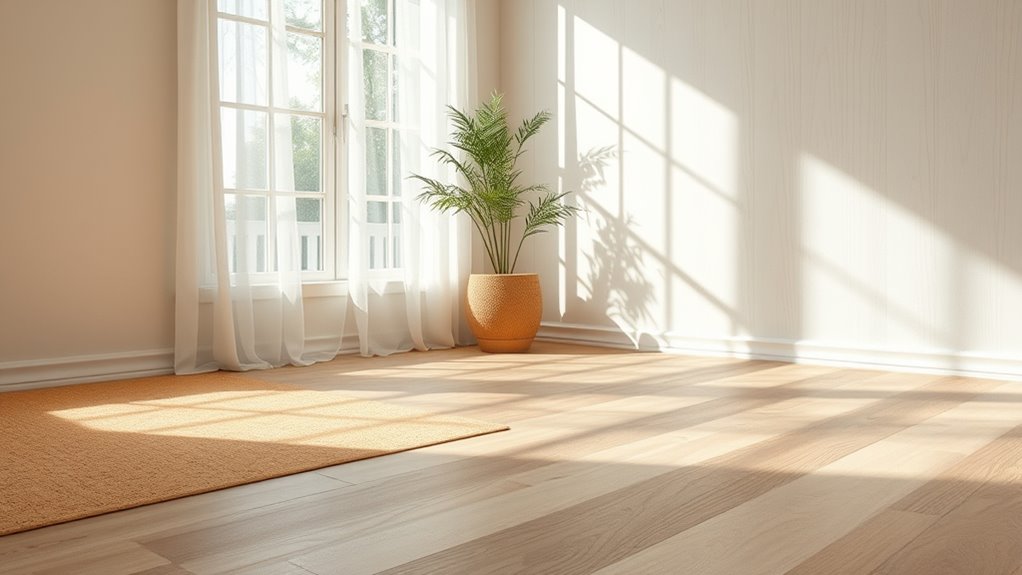
When choosing flooring to reduce joint and foot pain, it’s important to contemplate materials that provide cushioning and support. Cork flooring acts as a natural shock absorber, lessening joint impact and foot fatigue during long periods of standing or walking. Additionally, selecting materials with security vulnerabilities in mind can help prevent potential issues related to new flooring technologies. Rubber flooring offers excellent cushioning and slip resistance, making it ideal for high-traffic or exercise areas. Plush carpets with thick padding deliver superior underfoot support, warmth, and impact absorption for sensitive joints or feet. Soft flooring materials like vinyl and linoleum are more comfortable than hard surfaces, helping to alleviate pain. Moreover, some dog beds for Golden Retrievers are designed with supportive features that can complement your flooring choices to enhance comfort. Incorporating ergonomic design principles into your flooring selection can further promote comfort and reduce strain during daily activities. Using low-impact flooring options such as cushioned mats or area rugs can also help distribute weight evenly and minimize stress on joints. Additionally, area rugs or mats on hard floors can enhance cushioning and reduce strain.
How Shock Absorption Enhances Safety and Comfort
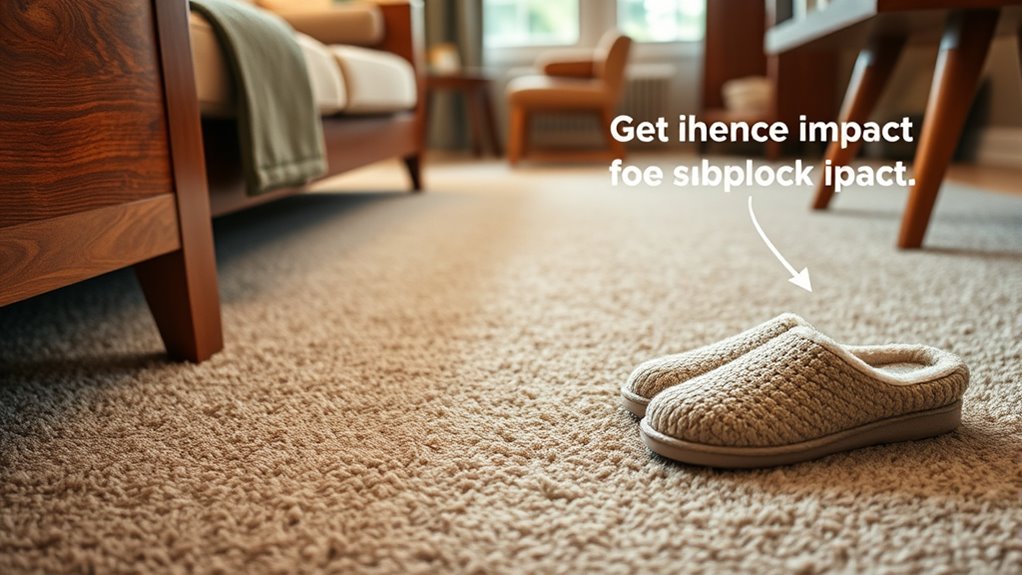
Shock absorption in flooring substantially boosts safety and comfort by reducing impact forces during standing or movement. Materials like rubber and cork can cut impact forces by up to 50%, easing joint strain and decreasing long-term damage. This cushioning helps protect your joints and spine from repetitive stress, especially on hard surfaces. Incorporating impact mitigation strategies into your flooring design can further enhance these safety benefits. Additionally, shock-absorbing floors distribute impact energy evenly, lowering the risk of injuries from slips or falls. The cushioned surface also provides better stability, making movement safer. Embracing flooring materials with shock absorption can improve overall safety for everyone, especially children, the elderly, and those with mobility challenges. By prioritizing shock absorption, you create a more comfortable and secure environment that reduces pain and minimizes injury risks. Proper installation techniques, such as correct subfloor preparation, can help ensure proper integration of shock-absorbing materials for maximum safety benefits.
The Role of Slip Resistance in Choosing Suitable Flooring
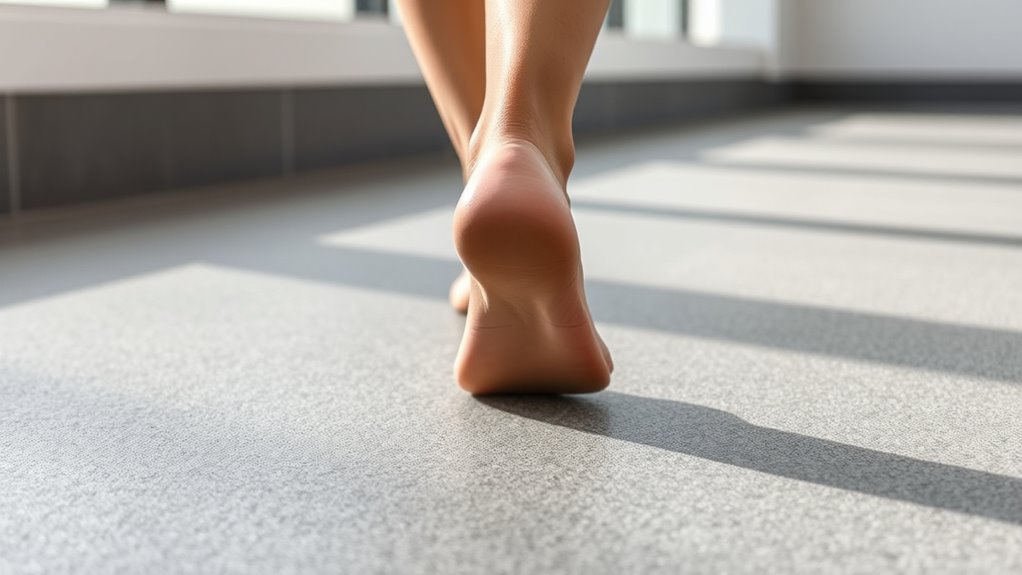
Have you ever slipped on a wet surface and wondered how to prevent it? Slip resistance plays a vital role in choosing flooring that keeps you safe. Textured surfaces or coatings increase friction, reducing the risk of slips and falls.
Materials like textured tiles, rubber, and vinyl with non-slip finishes are excellent options for high-moisture areas. Proper slip resistance is measured with standardized tests, such as the coefficient of friction (COF), where higher values mean safer surfaces.
In environments prone to moisture, spills, or humidity—like kitchens and bathrooms—slip-resistant flooring is essential. To maintain safety, regular cleaning and anti-slip treatments help preserve slip resistance over time.
Ultimately, prioritizing slip resistance ensures your flooring provides a secure, comfortable footing day after day.
- Textured surfaces enhance friction
- Non-slip finishes improve safety
- Higher COF values mean less slipping
- Moisture-prone areas demand better slip resistance
- Regular maintenance preserves safety
Maintenance and Durability of Supportive Flooring Types

Choosing supportive flooring that lasts requires understanding how different types withstand daily wear and tear. Durability varies across options, with vinyl and laminate flooring offering low-maintenance, scratch-resistant surfaces that resist stains and fading over time.
Cork flooring is naturally resilient, mold-resistant, and requires minimal upkeep to stay supportive and comfortable. Rubber flooring is highly durable, water-resistant, and easy to clean with simple sweeping or mopping, making it ideal for high-traffic areas.
Tile, such as porcelain or ceramic, also provides high durability and minimal maintenance, needing only regular sweeping and occasional sealing. Proper installation and routine cleaning, including vacuuming and sealing when necessary, extend the lifespan of supportive flooring types.
This ensures your floors remain supportive, safe, and easy to care for daily.
Incorporating Rugs and Carpets for Added Support and Style
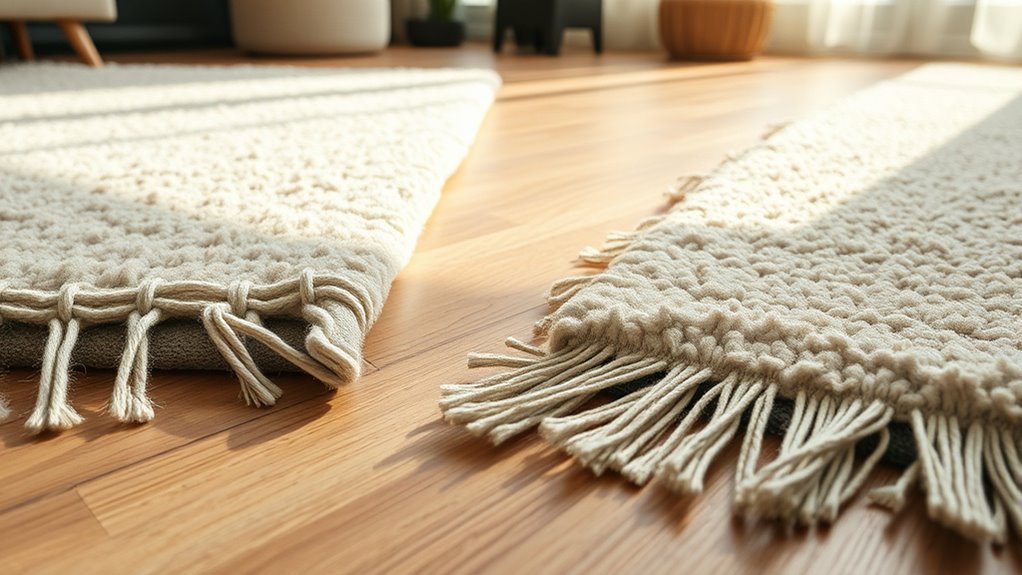
Adding rugs and carpets can boost comfort and warmth underfoot, making your space cozier. They also offer endless style and personalization options to match your decor.
Plus, many are easy to maintain and versatile enough to use in various areas of your home.
Enhancing Comfort and Warmth
Incorporating rugs and carpets into your flooring can considerably boost comfort and warmth in any space. They add plushness to hard surfaces, offering extra cushioning that reduces foot fatigue and joint pressure.
Thick carpets with quality padding enhance support, making standing and walking more comfortable for extended periods. Rugs and carpets also serve as excellent insulators, helping to retain warmth and create a cozy environment, especially during colder months.
Additionally, they improve safety by providing slip-resistant surfaces that lower fall risks. You can customize your space’s comfort and insulation by layering different rugs or choosing thicker carpets, all while elevating your interior’s style.
- Improve foot comfort and reduce fatigue
- Increase insulation for a warmer home
- Add support with plush padding
- Create a cozy, inviting atmosphere
- Enhance safety with slip-resistant surfaces
Style and Personalization Options
Rugs and carpets offer a versatile way to express your personal style while enhancing comfort in any room. With a wide range of styles, colors, and patterns, you can easily customize your space to match your décor preferences. Adding area rugs or carpets not only boosts visual appeal but also provides extra cushioning and support underfoot, especially on hard floors. Textured and plush options improve slip resistance and add coziness, reducing fall risk. Layering or coordinating rugs with existing flooring creates a unique, personalized interior. Seasonal updates are simple with decorative rugs, allowing quick style changes without permanent alterations.
| Style Options | Personalization Ideas |
|---|---|
| Traditional | Custom patterns and colors |
| Modern | Layered textures for depth |
| Vintage | Mix and match for uniqueness |
| Minimalist | Monochrome area rugs |
| Eclectic | Bold, statement pieces |
Easy Maintenance and Versatility
To enjoy the full benefits of rugs and carpets, choosing options that are easy to maintain is essential. These additions boost versatility by offering support, warmth, and cushioning, making hard floors more comfortable underfoot.
Area rugs and carpets come in various styles, colors, and textures, allowing you to personalize your space while enhancing functionality. For easy maintenance, look for machine-washable rugs or stain-resistant carpets that simplify cleaning and ensure longevity.
Additionally, carpets with quality padding increase softness and absorb shock, reducing foot fatigue. Using rugs or carpets over tough flooring also minimizes slips and falls, especially in high-traffic areas like kitchens and hallways.
- Easy to clean and maintain
- Enhances versatility and style
- Provides added support and comfort
- Improves safety by reducing slips
- Suitable for various interior designs
Eco-Friendly and Sustainable Flooring Choices for Comfort
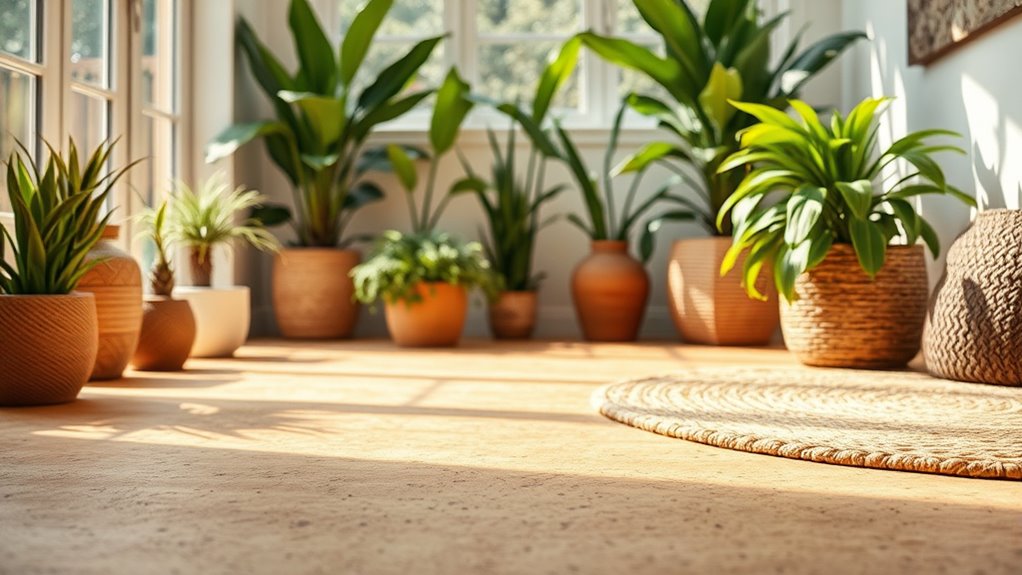
Choosing eco-friendly and sustainable flooring options not only benefits the environment but also enhances your comfort at home. Materials like bamboo are eco-friendly and sustainable, thanks to their rapid growth and ability to absorb carbon dioxide quickly.
Cork flooring is harvested from bark without harming trees, making it a renewable, comfortable, and durable choice. Linoleum, made from natural ingredients, offers a biodegradable, eco-conscious flooring option that reduces indoor air pollution with low VOC emissions.
Opting for sustainably sourced or reclaimed hardwood reduces deforestation and provides a durable, foot-friendly surface that’s comfortable to walk on. These eco-friendly flooring options contribute to a healthier indoor environment while ensuring durability and comfort, making your home both sustainable and pleasant for everyday living.
Tips for Proper Installation to Maximize Foot and Joint Benefits

Proper installation is essential to guarantee your flooring provides maximum comfort and minimizes foot and joint strain. To achieve this, start by making certain your subfloor is level, smooth, and free of debris, preventing uneven surfaces that cause discomfort.
Use high-quality underlayment suited to your flooring type to add cushioning and support, which helps absorb shock and reduce joint impact. Choose materials with good shock absorption properties, like cork or rubber, and install them carefully to maximize their benefits.
Follow manufacturer guidelines closely to avoid gaps, misalignments, or improper fastening that can lead to foot fatigue. For best results, consider professional installation to ensure precise placement, sealing, and consistent support, all of which help protect your joints and keep your flooring comfortable over time.
- Make certain a level, debris-free subfloor
- Select appropriate high-quality underlayment
- Opt for shock-absorbing materials like cork or rubber
- Follow manufacturer installation guidelines precisely
- Consider professional installation for maximum support
Frequently Asked Questions
What Flooring Is Easiest on Feet?
You’re asking which flooring is easiest on your feet. Carpeting and plush rugs offer soft cushioning, reducing impact and joint strain.
Cork flooring naturally absorbs shock, providing gentle support. Vinyl and linoleum are softer than tile or hardwood, making standing more comfortable.
Rubber flooring offers excellent shock absorption, and adding thick foam underlays to hard surfaces can further ease foot fatigue.
These options help keep your feet comfortable all day long.
What Is the Best Flooring for Bad Knees?
Think of your knees as delicate plants that need gentle care. To keep them happy, opt for soft flooring options like cork, rubber, or plush carpet, which cushion your steps and absorb shock.
Vinyl or laminate with cushioned underlays also help. Use textured mats over hard surfaces in busy areas. These choices act as a gentle hug for your knees, reducing pain and helping you move comfortably every day.
Is Vinyl Plank Flooring Hard on Your Feet?
Vinyl plank flooring can feel hard on your feet, especially if it’s thin and lacks cushioning. You might notice discomfort after standing or walking for a while.
To improve comfort, choose thicker planks with built-in underlay or add foam padding during installation. This extra cushioning helps reduce foot fatigue, making your flooring softer, more supportive, and easier on your feet during daily activities.
Which Flooring Is Best for Foot Pain?
If you’re wondering which flooring is best for foot pain, consider options that offer cushioning and shock absorption.
Carpeting and plush rugs provide soft support, while cork flooring naturally cushions your steps.
Thick vinyl or laminate planks help reduce impact, and soft, cushioned surfaces like foam-backed carpets or cushioned vinyl are ideal if you have conditions like plantar fasciitis or arthritis.
These choices help lessen discomfort and support your feet daily.
Conclusion
Choosing the right flooring can make a real difference in how your feet feel every day. By considering soft, supportive options and proper installation, you’ll enjoy greater comfort and reduce joint strain. Isn’t your well-being worth investing in flooring that cares for your feet? Remember, the right surface not only feels good but also promotes better posture and overall health—so choose wisely and step confidently into a more comfortable future.
